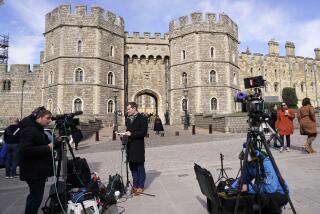Move Over,Charles and Di : The House of Windsor isn’t the only royal mess. Just look at the Grimaldis of Monaco.
MONTE CARLO, Monaco — The Grimaldis of Monaco tried to put a good face on the situation.
It was, after all, the annual Nov. 19 National Day celebration in the tiny principality on the sun-blessed Mediterranean coast--a time for the 4,700 Monegasques to honor their hereditary ruler, Prince Rainier.
But things have not been going well lately here in Camelot on the Cote D’Azur.
The 69-year-old prince is depressed, friends say. His face has a craggy countenance like the rocky bluffs above his eight-square-mile realm. His once-broad shoulders are slumped and droop listlessly above his ample paunch.
And there have been other problems. Princess Caroline, for example, and Prince Albert and Princess Stephanie--Rainier’s three handsome, trouble-plagued children.
You’ve heard about the troubles at the House of Windsor with Charles and Diana, Fergie and Andrew? Meet Europe’s other dysfunctional Royal Family: the Grimaldis of Monaco.
Sometimes, the family funk is all too evident. At a private awards ceremony Thursday in the central courtyard of the pink Grimaldi Palace, Rainier went through the motions, shuffling his feet on the cobblestone courtyard and muttering a few desultory words as he pinned service medals on the palace gardener, the palace cook, the palace zookeeper and assorted other palace staff and palace guard.
At the opera that night in the Monte Carlo Casino building, billed as an “Homage to His Serene Highness Prince Rainier III of Monaco,” Rainier sank deep into his flag-draped central balcony box, departing quickly after hefty Hungarian soprano Eva Marton finally sang the last tearful aria. Several hundred subjects in the ornate Salle Garnier theater, necks straining to catch a glimpse of their sovereign, managed only a tepid round of applause before-- poooff! --the prince was gone.
One palace insider says Rainier fell into a deep blue mood in September after observing the 10th anniversary of the accidental death of his beloved wife, American movie actress-cum-princess Grace Kelly.
“He’s just never been the same since Grace died,” agrees Olga Rinaldi, 73, owner of a fresh-fish stand in the local market.
In today’s high-beam media age, Europe’s royal families are finding it difficult to escape searing public scrutiny of their private lives, a domain once reserved for discreet court historians and sharp-tongued diarists like the 17th-Century French nobleman Saint-Simon.
The more people learn about the personal lives of their monarchs--aided in some cases by phone taps, lawyers and royal leaks--the more they discover how much their problems resemble those of . . . well . . . the common people.
Sex, adultery, crime--even violence--it’s all there, just as tawdry and petty as on “The Young and the Restless.”
Take Stephanie, for example. The youngest of the Rainier-Kelly children, 27-year-old Stephanie has already had a career as a model, rock singer and perfume creator-marketer.
But Stephanie did not attend the National Day festivities this year because she is more than eight months pregnant with the child of bodyguard-boyfriend Daniel Ducruet. Ducruet, also 27, is a muscular, dark-haired young man fond of gold chains, hang gliding and tattoos. He showed off his latest tattoo--a red, yellow and blue winged dragon emblazoned on his chest--in a recent photo spread for Paris Match, the slick French photo journal.
Ducruet says he intends to marry Stephanie, but admits also that he recently fathered a son, now 9 months old, by another girlfriend.
“I’m frank,” he said in an a joint interview last summer with Stephanie for the Paris Match article. “That’s why people either like me or don’t like me. It’s time for me to set the record straight.”
Ducruet complained that a magazine article had falsely accused him of abandoning the other woman and the child.
“It accused me of being an executioner and said Stephanie was a daddy stealer,” Ducruet fumed, explaining that he has taken financial responsibility for the first child.
Last week Ducruet faced another problem: A motorist in Nice, France, named him in an assault complaint, alleging that Ducruet and another Grimaldi family bodyguard beat him up after a highway argument last January.
The motorist, Jean-Christian Raymond, identified Ducruet from photographs after the license plate of the four-wheel-drive Jeep Cherokee involved in the incident was traced to Princess Stephanie. An arrest warrant for Ducruet--also wanted in connection with a 1990 brawl in which he allegedly broke the nose of another motorist--was issued in a Nice court on this year’s Monaco National Day.
The Ducruet episode in Princess Stephanie’s life is a major embarrassment for the Grimaldi family, which has never officially recognized the existence of Stephanie’s lover except to assign him his own bodyguard.
But Stephanie is not the only member of the Grimaldi family--which has been the ruling clan of the land called “The Rock” for nearly 700 years--with big-time problems.
First, there’s the brooding prince himself: Rainier III, Sovereign Prince of Monaco, absolute monarch of a tiny territory that makes most of its money from tourism, tax-sheltered banking and gambling.
As celebrity historian Anne Edwards noted in her recently released book, “The Grimaldis of Monaco,” the principality has thrived under Rainier’s 43-year reign.
Described by his loyal subjects as “the builder prince,” Rainier supervised the transformation of the principality from an exclusive resort for the very rich to a popular--although still hideously expensive--international convention site. To provide space for the new hotels and office buildings (40 banks with deposits totaling more than $10 billion have branches here), Rainier reclaimed land from the sea.
Along the way, he steered his tiny ship of state through such formidable obstacles as Aristotle Onassis, forced by the prince to relinquish control of the famous Monte Carlo Casino in 1964, and the late French President Charles De Gaulle, who once threatened to annex Monaco if Rainier didn’t allow French tax collectors into the Monaco bank files.
With his marriage to Kelly in 1956, a $2-million wedding attended by nearly 2,000 international journalists, Rainier turned a place once described by writer Somerset Maugham as “a sunny place for shady people” into a Magic Princedom.
Kelly, daughter of American Irish immigrants, was at the height of her elegant beauty and fame as an actress. To everyone’s surprise, the marriage stayed strong and true, with nary a hint of scandal, until her death in an automobile accident in 1982.
“It was a dream come true,” remembers Nadia Lacoste, former press attache for the ruling family, “an attractive prince had married the leading talent of the time. They lived in a sunny country. They had beautiful children.”
Still, the beautiful eldest of the Rainier-Kelly progeny, 35-year-old Caroline, remains in mourning after the death of her second husband, Italian Stefano Casiraghi, in a speedboat accident two years ago.
At the National Day Te Deum Mass celebrated last week at the Monaco Cathedral, Caroline draped her head in a black lace shawl. At the conclusion of the service, she followed her father down the aisle with head bent forward, her delicate chin resting in the hollow of her throat: the very picture of grief.
The popular French press, hounding the princess and her three children, ages 8, 5 and 4, at her retreat in a small city near Arles, claims that Caroline would like to wed again--this time to French actor Vincent Lindon, 33.
Problem is, the Roman Catholic Church never recognized her marriage to Casiraghi because of Caroline’s earlier impulsive marriage to French playboy Philippe Junot.
This summer, aided perhaps by her father’s refusal to pay his annual $800,000 tithe to the church until the matter was settled, Caroline finally won an annulment from Rome for the Junot marriage. But her three children by Casiraghi still remain illegitimate in the eyes of the Catholic Church until Caroline remarries--and, unless she remarries in the church, that makes them ineligible to inherit the throne. (Would-be husband Lindon is Jewish and would have to convert to Catholicism for the church to recognize any marriage there.)
Legitimizing the Casiraghi children may be important because, up to this point, the heir to the throne, Prince Albert, 34, has shown no serious signs of a desire to get married and produce his own children.
There was a flurry of hope in the principality this summer when the young prince--among the three Rainier-Kelly children, the closest in appearance to Grace--was romantically linked in the tabloids to German supermodel Claudia Schiffer, a sometime resident of Monaco.
But that rumor, like many before it, seems to have evaporated. Athletic Prince Albert, considered one of the most eligible bachelors in Europe, still appears more interested in tennis than matrimony.
Nevertheless, palace spokesmen refused comment last week on a report in USA Today that a California woman, Tamara Rotolo, had filed a paternity suit naming Albert as the father of her child.
For some Monegasques, however, even that report was a good sign. Frustrated by Prince Albert’s slow march toward the altar, they seemed ready to accept any signal that he was ready to produce heirs.
Despite the trials and travails of the Grimaldis’ private lives, there is no sign of any flagging devotion for the ruling family among the Monegasque people. A minority in a population of 27,000 who live in Monaco, the 4,700 subjects of the House of Grimaldi are pampered citizens who benefit from housing allowances and other benefits far greater than those found in neighboring France and nearby Italy.
Indeed, students of Monaco’s history know that the Grimaldi family has endured much more trying moments. In her book, subtitled “The Centuries of Scandal, the Years of Grace,” author Edwards describes the fate of one of the early Grimaldi rulers, Hercule:
After ruling for 15 years, Edwards wrote, “Hercule was stabbed to death in a narrow, dark alley in Monaco by a group of Monegasque men whose daughters he had defiled. His body was thrown over the cliff into the sea.”
On a far lesser scandal scale, Rainier himself was the product of a broken marriage. For many years, his father, Prince Pierre-Marie-Xavier, Count of Polignac, was banned from the principality. But with this kind of historical tradition, the Monagasque people appear willing to forgive all--even the latest episode with Princess Stephanie.
“Life is short,” says Olga Rinaldi, chatting over a tray of iced Mediterranean sea bass in her market stall. “If she can find happiness that way, she should. I had seven children. They were all from the same marriage. But that was how it was done in those days.”
More to Read
Sign up for The Wild
We’ll help you find the best places to hike, bike and run, as well as the perfect silent spots for meditation and yoga.
You may occasionally receive promotional content from the Los Angeles Times.






